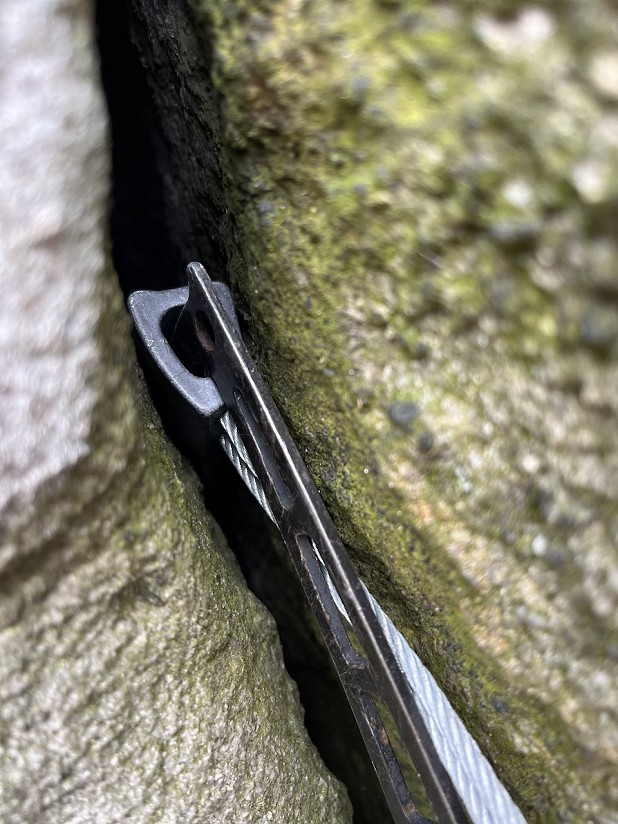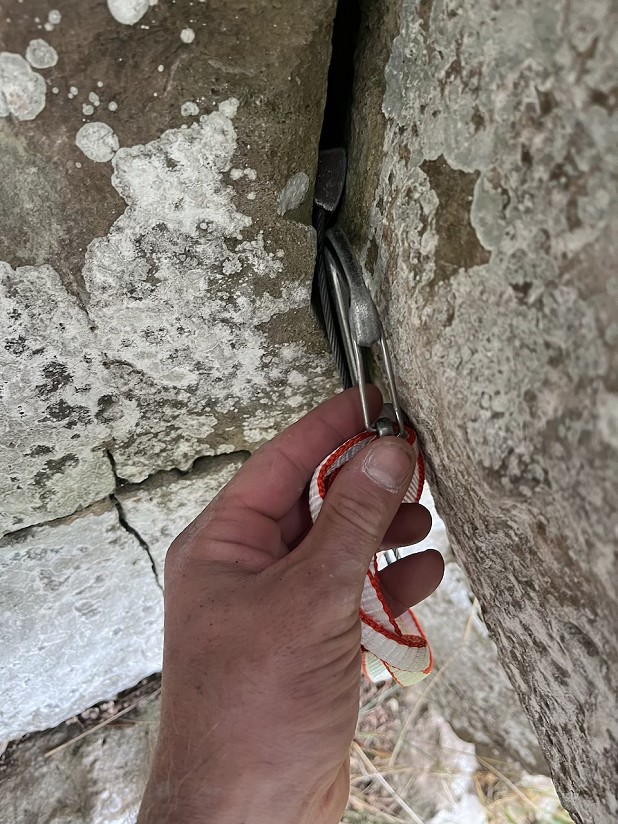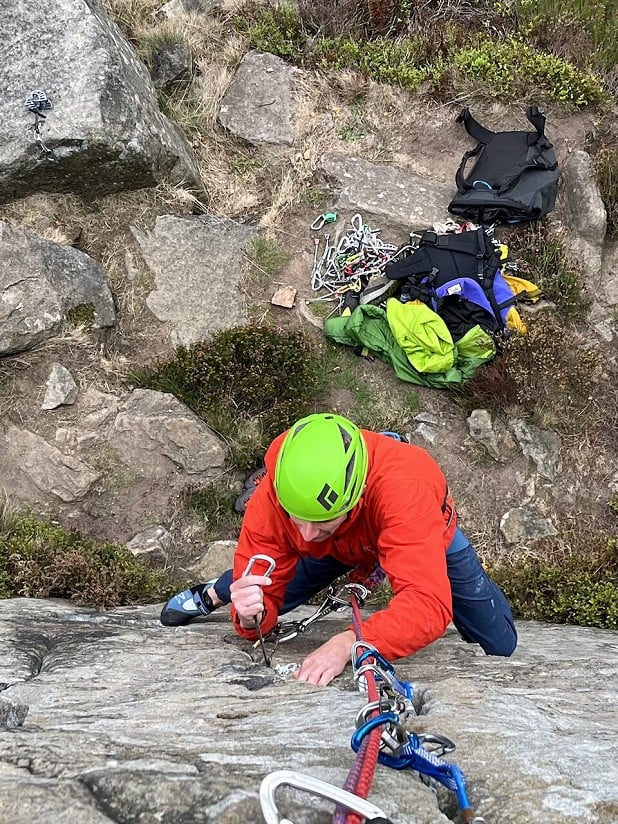
Tom Ripley shares some tips on how to keep hold of wires, even when they seem like they might be lost forever.
I'm 32 years old, and have been climbing obsessively for 19 years. I got my first wires (two sets of DMM Wallnuts - I'm 99% certain that none of the original wires remain) at the age of 13, and whilst I've purchased the odd wire here and there, I've never purchased a full set since. Why? Chiefly, because I'm handy and persistent with a nut key.
Below are eleven handy tips for keeping your rack in your possession, and hopefully expanding it!
On a slightly more serious note, fixed wires rot, especially on sea cliffs. It's a good idea to try and remove them, as - if left - there will all too soon be a rotting hunk of alloy blocking the crucial placement.
1. 'The Big Whip'
This is a favourite, particularly if I'm pumped. Imagine you're seconding a tough pitch in Huntsman's Leap. Your gallant leader has (sensibly) cold welded in four wires before committing to the crux sequence. Just thinking about reaching for your nut key fills your forearms with lactic acid.
Instead, unclip the quickdraw from the rope and give it a violent whip upwards. This should shock-load the wire and unstick it from the rock, allowing you to wiggle it out and keep climbing before your forearms explode. If the first big whip doesn't work, keep trying. In my experience 'The Big Whip' works best with medium length quickdraws. 60cm slings are too long, and short stiff draws don't seem to work as well.
Whipping micro wires. Micro wires are small, I guess the clue's in the name. Like most bits of lightweight gear, they're a bit more delicate. I'd avoid whipping them out unless they're totally welded in place - in which case they've probably been fallen, aided, or rested on. If you do whip them out, don't be surprised if the wires start to fray. That said, whipping out your wire and destroying it the process is better than leaving a ticking time bomb in the rock for some unfortunate soul to lob on.
2. 'The Nut Key Torque'
This is another favourite of mine. Bigger wires (Wallnut/Rock 7 and above) have a hole through them to make them lighter. This can be used to your advantage when big nuts are stuck. Stick the end of your nut key into this hole and twist, this normally results in a very stuck nut becoming unstuck very quickly. This is even more effective with an ice axe!
3. 'The Carabiner Tap'
This is good for medium to large nuts (Wallnut/Rock 6 and above). If 'The Big Whip' doesn't work, use the rope-end carabiner (from the quickdraw the wire is clipped to) to tap the wire out. I find this is pretty effective with slightly stuck wires, and is a lot quicker than reaching for your nut key every time.
4. Don't use offsets
Offsets wires are great - particularly in granite peg scars, which Hugh Banner designed them for - but they get stuck way more easily than normal wires.
5. 'The Rock/Hex/Belay Plate Hammer'
If someone has taken a big lob onto a wire, it can often be well and truly welded. If this is the case, try using a hex (belay plates and big cams are poor substitutes) to hammer your nut key against the nut. I often find a small rock is even better as it has a bit more heft behind it. If I'm abseiling down to retrieve a stuck wire I'll often take a rock in my chalk bag - obviously don't do this at a busy crag! A peg hammer would be ideal for this task.
6. Think about it!
This sounds simple, but before you start blindly stabbing at the wire with your nut key, take a moment to look at it, and consider how the leader placed it. If they're in earshot, shout up to the leader and ask them how they put it in.
7. Don't give up
Wires are expensive, roughly the cost of a pint in Langdale! Don't give up until you've got your wire back, or it's gone dark, or your mate has tied you off and gone to the pub! Use any and all of these techniques, as well as some ingenuity of your own.
8. Use both hands
It's amazing how easily a wire will come out if you use both hands to get it out. Either sit on the rope, or clip in hard to another piece. Clipping in hard is often my preference, as you won't move down the crag on rope stretch, and you don't need to communicate with your belayer to do so.
9. Cam/wire to prise flake open
If you've placed the wire behind a loose flake - something I'd get out of the habit of doing if I were you - and it's now stuck, place a bigger wire or cam above it. This should now prise the flake open, allowing you to remove the stuck wire. Fingers crossed you can now remove the bigger piece you placed to remove the first.
10. Strangle it
If you pinch the wire near its head you can apply more leverage to it, making it easier to wiggle out. This works well for wires that are loose but are stuck in a constriction that needs to be navigated through.
11. Don't weld them, Extend them
This is more of a tip for folks that take novices climbing, and one that I learned the hard way on my British Mountain Guides summer test. Rather than whacking your wires in and cold welding them to the rock, place them more carefully, ideally dropped deep in cracks, and then extend them with long slings so that the rope doesn't lift them out. If you're climbing anywhere near your limit, my advice is to ignore this and cold weld them in like your life depends on it - it does!
What tips or techniques do you use to keep hold of your gear? Share them in the comments below!
- REVIEW: Mountain Equipment Vega - update of a classic 5 Apr
- DESTINATION GUIDE: Meteora, Greece - A Sport Climbing Area for Trad Climbers 4 Jan
- REVIEW: Haglofs Roc Sheer GTX Jacket 14 Nov, 2023
- REVIEW: Edelrid Salathe Lite - the best helmet is the one you'll want to wear 13 Jun, 2023
- REVIEW: North Wales Climbs Rockfax 30 May, 2023
- DESTINATION GUIDE: Mount Kenya 30 Mar, 2023
- ARTICLE: Things I Learned While Climbing (and previously failing on) The Nose of El Capitan 17 Nov, 2022
- ARTICLE: 12 Ways to Save Cash on Outdoor Gear 8 Sep, 2022
- GEAR NEWS: Guided Trip to Mingulay - Saturday 7 to Friday 13 May 2022 9 Feb, 2022
- REVIEW: Mountain Equipment Vega Jacket 23 Mar, 2021






















Comments
No mention of the 'wire slide!'.
Slide the wire through the nut, clip the loop at the opposing end of the wire and yank.
I find that works really easily with WC rocks, but with DMM wallnuts, the wire can be much more tricky to push through. Actually find that can happen with WC rocks too easily/inadvertently when trying to place the nut in a fiddly crack.
Nice article, definitely a tip or two there I hadn't come across. I hope there will be a sequel for cams.
That is a good one, which I have done on occasion. Just not recently as I’d totally forgotten about it.
Wires that are in a tight crack(!) and sometimes be 'walked out' by pushing each wire up alternately and wiggling it towards the daylight,
Chris